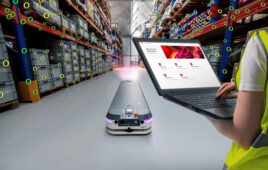Fuel is a significant expenditure incurred by private fleets, public transportation companies, and other organizations, so close monitoring and management of this resource is essential. Integrated Command Systems (ICS) is expert in fuel management and specializes in automated fueling systems that maintain and disperse gasoline, oil, coolant, and other fluids for large fleets of taxis, cars, buses, trucks and other vehicles. The company’s ICSystem-6 is its premier fuel and fluid management system.

The older system communicated through RS-422 and involved a lot of wiring.
ICS has worked with the Massachusetts Bay Transportation Authority (MBTA), the oldest and fourth largest transportation authority in the US. It provides transportation for nearly 1,000,000
passengers daily, so it must fuel approximately 1,600 vehicles per day. The ICSystem-6 for MBTA:
– Logs fuel, fluid consumption, and mileage of each vehicle to predict potential failure and reduce downtime.
– Ensures fuels and fluids go only into the intended vehicles.
– Ensures that fuel and fluid deliveries are received in the quantities invoiced by the suppliers.
– Reconciles inventory levels with deliveries and usage.
– Schedules vehicle maintenance at the proper intervals.
– Ensures that vehicles do not leak fuel or fluid into the environment, to comply with environmental laws and regulations.

SNAP PAC brains are communications and I/O processors that interface to SNAP I/O modules. They are similar to bus couplers in function in that they communicate from the controller to the remote I/O without wiring each point separately.
To guarantee that its PC-centered ICSystem-6 performs all of these functions, ICS went to a platform that includes software and SNAP PAC components from Opto 22. The previous control system hardware could only communicate through an RS-422 serial interface. ICS worked with Martindale Associates–experts in system design and software systems for automation, data acquisition, and other applications–to replace this unit with an Ethernet-based Opto 22 SNAP PAC brain.
SNAP PAC brains are communications and I/O processors that interface to SNAP I/O modules. While similar to bus couplers in function, in that they communicate from the controller to the remote I/O without wiring each point separately, there is a key difference–SNAP brains are intelligent processors that distribute control. Thus, you can latch, count, pulse, scale, and clamp, and manage PID loops and thermocouple linearization right at the I/O module.
“Our fueling and fluids management system is PC-based, with a supervisory site PC running custom ICS software and up to four ‘island’ controller PCs,” said Mark Bruno, vice president of Engineering, ICS. “The site PC polls the islands and monitors and controls above-and below-ground fluid tank pumps.”
Powered by the SNAP PAC controller, the ICSystem-6 connects to, controls, and sequences pump solenoid valves. The controller counts pulses to determine how much fuel has been pumped, and then uses the data to execute a variety of start/stop logic for the pumps.
The SNAP PAC brain uses Ethernet, enabling the ICSystem-6 to easily interconnect the distributed I/O. The configuration eliminated the need for dedicated communication links and lengthy or cumbersome wiring runs.
The MBTA’s fuel monitoring and management system runs 24 hours a day, managing the fuel levels in the 20,000 gallon in-ground tanks. New fuel deliveries come in 10,000-gallon increments. The system program prevents the tanks from falling below a minimum of 2000 gallons (per tank), so as to avoid damage to the internal pumps. Fuel deliveries are allocated between tanks to keep each at the required fuel levels.
Opto 22
www.opto22.com
::Design World::
Filed Under: Factory automation, Ethernet — cables • hubs • switches, I/O modules, CONNECTIVITY • fieldbuses • networks, Green engineering • renewable energy • sustainability, ENGINEERING SOFTWARE, PLCs + PACs





Tell Us What You Think!